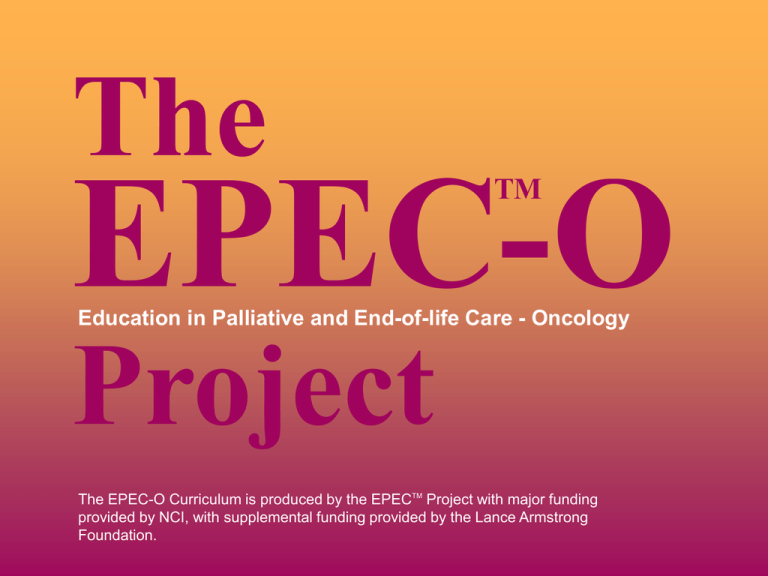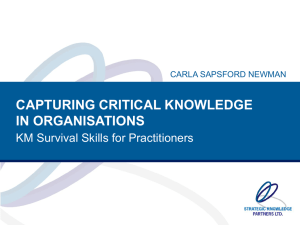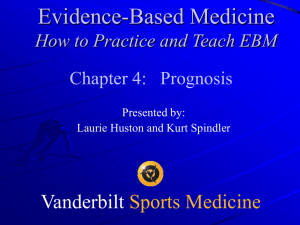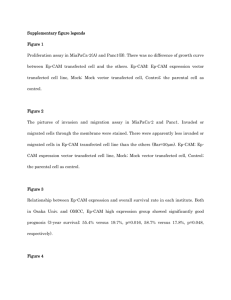slides
advertisement

The EPEC-O TM Education in Palliative and End-of-life Care - Oncology Project The EPEC-O Curriculum is produced by the EPECTM Project with major funding provided by NCI, with supplemental funding provided by the Lance Armstrong Foundation. E P E C O EPEC - Oncology Education in Palliative and End-of-life Care - Oncology Module 8 Clarifying Diagnosis and Prognosis Objectives Describe the difficulty with prognostication Discuss limitations of current prognostic models Apply the 6-step protocol to communicate diagnosis and prognosis Video Importance Most people want to know Strengthens physician-patient relationship Fosters collaboration Permits patients, families to plan, cope Inaccuracy of prognostication9 Studies of Clinical Predictions of Survival vs Actual Survival Study # Patients Median CPS (days) Median AS (days) Parkes et al1 71 28 (45-56) 21 (9-34) Evans et al2 42 81 (28-182) 120 (43-180) Heyse-Moore et al3 50 56 (33-84) 14 (7-28) Maltoni et al4 100 42 (28-56) 32 (13-63) Maltoni et al5 530 42 (28-70) 32 (13-62) Oxenham et al6 21 21 (14-35) 15 (9-25) Maltoni et al7 451 42 (21-70) 33 (14-62) Christakis et al8 325 77 (28-133) 24 (12-58) 1,591 42 (28-84) 29 (13-62) Overall Clinical predictions vs. actual survival Over optimistic by factor of 3 - 5 Glare P. BMJ. 2003. Clinical predictions vs. actual survival Relationships between predictions and survival Actual is 30% less than predicted Survival = predicted 1 week for 25% Predicted survival + 4 weeks for 27% Glare P. BMJ. 2003. Sources of prognostic information Physician prediction Stage-specific survival data Performance status Signs and symptoms Integrated models Sources of survival data . . . Stage specific survival curves Natural history studies Randomized trials with a ‘best supportive care’ arm Natural history studies N Median survival (Years) Actuarial 5-year survival % Breast14 250 2.7 18.4 Breast14 1,022 2.3 19.8 808 0.32 0 Cancer type Head and neck15 Performance status and prognosis . . . Independent prognostic factor Karnofsky Performance Score <50: survival <8 weeks Mor V, et al. Cancer. 1984. . . . Karnofsky Score as predictor of survival KPS Survival in days 50 86.1 30-40 49.8 10-20 16.8 Reuben DB, Mor V, Hiris J. Arch Intern Med. 1988. Clinical signs and symptoms as prognostic indicators in patients with advanced disease Symptom Median survival Dyspnea5 <30 days Dysphagia5 <30 days Confusion/delirium23,24 <28 days Xerostomia20 <50 days Weight loss (10 kg) <28 days Prognostic impact Index Hypercalcemia Median survival (Months) 1 - 4.5 Brain metastases plus surgery 9.5 Brain metastases without surgery 4 Pleural effusion 3 6-step protocol . . . 1. Getting started 2. Find out what the patient knows 3. Find out how much the patient wants to know Adapted from Robert Buckman Communicating prognosis . . . Some patients want to plan Others are seeking reassurance . . . Communicating prognosis . . . Limits of prediction Hope for the best, plan for the worst Better sense over time Can’t predict surprises, get affairs in order Reassure availability, whatever happens . . . Communicating prognosis . . . Inquire about reasons for asking “What are you expecting to happen?” “How specific do you want me to be?” “What experiences have you had with: others with same illness?” others who have died?” . . . 6-step protocol 4. Share the information 5. Respond to patient, family feelings 6. Plan, follow-up Adapted form Robert Buckman . . . Communicating prognosis Patients vary ‘Planners’ want more details Those seeking reassurance want less Avoid precise answers Hours to days. . .months to years Average Summary Prognostication is inexact Karnofsky performance status is an important prognostic factor In advanced (<3 months) disease, symptoms predict prognosis Prognosis is difficult to define for patients with survival >6 months











